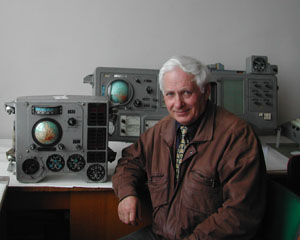The Third Generation
|
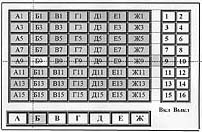
Structure of command-signal field |
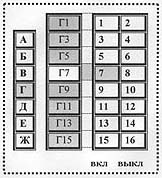
Structure of command-signal device |
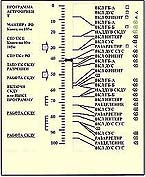
Program control indicator panel in the test mode |
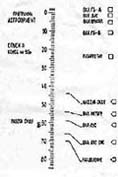
Program control indicator panel in the
reentry
mode |
|
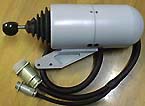
|
|
Finger controller on Soyuz |
The third generation of information display systems (IDS) includes command-signal devices that use command-information compression of the second type. Figures above depict the structure of command-signal field and the structure of command-signal device. Such systems implement a compression of the information field of analog parameters; these systems include devices for information exchange with onboard computer systems and CRT television-type devices for video monitoring, which combines TV and measurement analog information. The main tools are multifunctional indicators based on vacuum tubes, and electroluminescent and plasma displays. An example of the third generation is Sirius information display systems for the Soyuz-7K, Soyuz M, and Soyuz A8 spacecraft and for the long-term orbital station Salyut. A typical Sirius IDS includes two command-signal devices, an instrument board, and two (left and right) finger controllers.
|
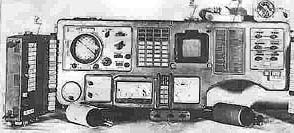
|
|
Instrument board and command-signal device of
the IDS Sirius on Soyuz-7K, A8, DOS-17K |
These systems implement the principle of programmed temporal monitoring and control. On the program control indicator panel (above), a pointer moves along the time line. When the pointer reaches the mark of a particular command or a signal, an indicator on the right would light up when this command is executed. If the indicator does not light up, the operator enters this command via the command-signal device and monitors its execution by observing the corresponding indicator on the program control indicator panel.
The Fourth Generation
|
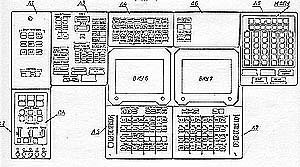
|
|
Control panel for approach of the IDS Vega on the
Buran space shuttle |
In the fourth generation of IDS, the most important role in presenting information to cosmonauts belongs to onboard computers and computer display systems. Examples of fourth-generation systems include IDS Neptun with display processor Simvol for the Soyuz T and the Soyuz TM spacecraft, control panel for the onboard computer complex DISK-1B of the Almaz complex, display systems of the STEK complex on the long-term orbital station MIR, and IDS Vega of the reusable spacecraft Buran.
The Fifth Generation
|
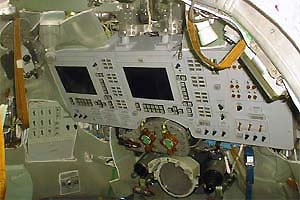
Main cosmonaut console on Soyuz-TMA |
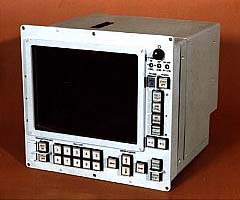
Integrated control console on the utility
module of the Alpha International Space Station |
The fifth generation of IDS is distinguished by the high degree of integration of means and methods of information display. Unlike the previous generation, fifth-generation IDS incorporate their own computer systems, video-processors, and graphics adapters. These systems begin to implement dialogue principles with the use of graphics, text, sound, and speech. Examples of fifth-generation IDS are information display systems for the utility module of the International Space Station Alpha, including an integrated control panel, and IDS Neptun-ME of the modernized spacecraft Soyuz TM.
In IDS of the fifth generation, devices with selective command entry systems (command-signal devices and fields), autonomous devices for information exchange with an onboard computer, measurement systems and digital display processors are all integrated into a unified electronic dialogue system. The human-machine interface is implemented as a human-computer graphic interface. At this stage, a transition is made from displays based on CRTs to flat-panel indicators based on plasma panels and electroluminescent displays.
Conclusion
Our analysis of the technical means and methods of information display in IDS for Russian spacecraft suggests that Russian engineers have pioneered the design and testing of the following innovative solutions:
-
introduction of push-button controls and lateral hand controllers for spacecraft in a wide assortment of types;
-
elaboration of design principles and the actual construction of various types of command-signal control panels of the selective type with or without signaling about changes in the condition of the system;
-
elaboration of the principles of construction of combined systems for control and observation and the actual construction of multi-function indicators based on CRTs,
electroluminescent, cathode-luminiscent, and plasma displays;
-
elaboration of design principles and the actual construction of means of programmed temporal control and monitoring;
-
construction of multi-scale and two-axis indicators with light readings, multi-scale plasma indicators of parameters,
etc.
One of the most important achievements is the transition to the computer and information technologies recently termed COTS-technologies. A major component of such systems if a human-computer interface. IDS based on COTS-technologies are installed on the utility module of the International Space Station and on the modernized space ship
Soyuz-TMA. These systems open a new page in the development of ergatic control
systems.
See also other articles by Yurii Tiapchenko:
Information Display
Systems for Russian Spacecraft: An Overview
Information
Display Systems for Russian Spacecraft: Generations I and II
Information
Display Systems for the MIR Space Station and the Soyuz Transport Ship
Information Display
Systems for Soyuz-TMA and the International Space Station
Interview
with Yurii Tiapchenko
|
